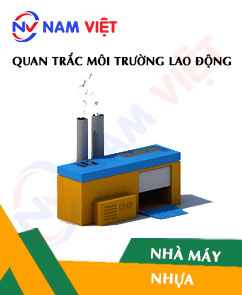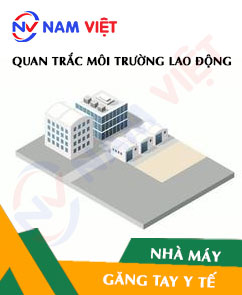Occupational environment monitoring of a plastic manufacturing factory
99,000 ₫
Note: The above price is calculated for one sample, and the price may fluctuate depending on the area of the environment to be monitored and market movements. For more accurate pricing support, please refer to the price list or contact our consulting staff directly.
Monitoring the environment of a plastic manufacturing factory is a session of collecting, analyzing, and evaluating factors at the workplace that may harm workers health.
Table of Contents
Toggle1. Overview of Plastic Factories
a. What is a plastic factory?
A factory that produces plastics is an industrial facility used to manufacture and process plastic products. Plastic is a type of synthetic or natural material, typically produced from organic compounds. This factory uses specialized processes and equipment to convert raw plastic materials into final products.
The types of plastic products manufactured in a plastic factory can be very diverse, including plastic bottles, plastic pipes, plastic sheets, plastic films, plastic containers, household plastic products, automotive parts, electronic products, and many other products.

b. Production stages in a plastic factory
The production stages in a plastic factory may include the following steps:
- Raw material preparation: Plastic raw materials are prepared and quality-checked before use in the production process. This includes selecting the appropriate type of plastic, measuring, and mixing additives if necessary.
- Mixing and heating: Plastic raw materials and additives are mixed together to form a plastic compound. The mixing process may use equipment such as conveyor mixers or centrifugal mixers. Temperature and mixing time are controlled to achieve uniformity and the desired quality of the plastic compound.
- Injection molding: During injection molding, the plastic compound is fed into an injection molding machine. The compound is injected into a mold under high pressure to form the final product. Once the plastic cools, the mold opens, and the product is ejected.
- Compression molding: Compression molding uses high pressure and heat to mold plastic in a compression mold. The plastic is placed in the mold, and pressure is applied to form the final product. This process is commonly used for large or complex plastic products.
- Additional processing: After injection or compression molding, plastic products may require additional processing steps for finishing. This may include cutting, grinding, drilling, surface treatment, assembly, or other processes to create the final product according to specific requirements and design.
- Quality inspection: Each production stage in a plastic factory requires quality checks to ensure the final product meets standards and quality requirements. Inspections may include size verification, strength testing, heat resistance testing, and other criteria.

c. Types of machinery used in a plastic factory
In a plastic factory, various machines and equipment are used to carry out plastic production and processing. Some common machines include:
- Plastic mixers: Used to mix and heat plastic compounds and additives. Types include conveyor mixers, centrifugal mixers, and twin mixers.
- Plastic injection molding machines: Used to inject plastic compounds into molds to create complex-shaped plastic products. They include a plastic pumping system, mold system, and control system.
- Plastic compression molding machines: Use high pressure and heat to mold plastic in compression molds. Types include horizontal and vertical compression molding machines.
- Cutting and processing machines: Include plastic cutters, surface processing machines, drills, grinders, and lathes for additional processing of plastic products.
- Plastic grinders: Used to grind and recycle waste plastic or unwanted plastic pieces into small pellets for reuse in production.
- Plastic extruders: Used to extrude plastic compounds into pellets or sheets. Extruders include feed systems, screw mechanisms, and control systems.
- 3D printers: Use 3D printing technology to create complex plastic shapes without traditional molds.
- Heat treatment equipment: Includes drying ovens, kilns, softening ovens, and other equipment to treat plastics with heat during production.

d. Occupational diseases that may occur in plastic factory workers
Workers in a plastic factory may suffer from some occupational diseases due to exposure to chemicals and harmful environmental factors. Some common occupational diseases in the plastic industry include:
- Skin allergies: Exposure to chemicals such as cleaners, plastic additives, or plastic compounds may cause skin allergies, leading to itching, redness, inflammation, and scaling.
- Respiratory problems: Chemicals such as color fumes, petrochemical gases, or fine plastic particles can irritate the respiratory tract, causing pneumonia, asthma, sinusitis, and other respiratory issues.
- Chemical-related occupational diseases: Certain chemicals in plastic production may lead to occupational diseases such as hepatitis, kidney damage, nerve damage, digestive disorders, and other conditions.
- Hearing-related diseases: Noise from machinery and equipment in plastic factories may cause hearing problems such as hearing loss, tinnitus, and balance issues.
- Environmental pollution: Some plastic production processes may cause environmental pollution, including air emissions, solid waste, and wastewater. Workers may face health risks due to exposure to toxic substances.
To ensure worker safety, labor protection measures such as personal protective equipment, occupational safety management, environmental pollution control, and safe work procedures must be applied in plastic factories.

e. Types of products in a plastic factory
Plastic factories produce various products depending on the type of plastic and production process. Some common products include:
- Consumer products: Daily-use plastic items such as water bottles, food containers, oil bottles, beverage cans, plastic bags, household items like pipes, brushes, and storage boxes.
- Packaging products: Plastics used in packaging, such as food bags, plastic packaging, films, cosmetic jars, pharmaceutical bottles, chemical bottles, and electronic product containers.
- Industrial products: Plastics used in industries such as plastic pipes, sheets, elbows, valves, plastic machinery parts, automotive parts, and insulation materials.
- Medical products: Plastics used in healthcare such as medical tubing, medicine containers, syringes, medical combs, and surgical plastics.
- Construction products: Plastics for construction including drainage pipes, soundproof and insulation materials, waterproofing materials, roofing sheets, plastic doors, trims, and water pipes.
- Electronics products: Plastics for electronics such as computer cases, keyboards, hard drives, cable conduits, and electronic components like connectors and sensor tubes.
- Automotive products: Plastics for automobiles including interior parts, lamp covers, windows, fuel pipes, and cooling components.

2. Overview of Occupational Environment Monitoring Services
a. What is occupational environment monitoring in plastic factories?
Occupational environment monitoring (or workplace environmental measurement) in plastic factories is the activity of collecting, evaluating, and analyzing measurement indicators of workplace environmental factors in plastic factories, in order to implement timely solutions, minimize environmental harm to workers’ health, and prevent occupational diseases. Occupational environment monitoring is mandatory for plastic manufacturing facilities.
Monitoring plays a crucial role in caring for, protecting, and enhancing workers’ health, as workers are the primary resources of a company and directly generate profit. Workers regularly exposed to hazardous factors above permissible limits can suffer health impacts and occupational diseases.
REGISTER FOR OCCUPATIONAL ENVIRONMENT MONITORING SERVICE
b. Nam Viet’s occupational environment monitoring program
Nam Viet’s occupational environment monitoring program is developed by monitoring engineers specializing in occupational safety and environmental protection. Aiming to ensure worker health and safety, the program uses modern measurement methods to monitor air, water, microclimate, physical factors, dust, and other workplace environmental elements. This program is critical for ensuring a safe working environment and protecting worker health.
Moreover, Nam Viet’s program also plays an important role in researching and developing new solutions to improve workplace environmental quality. With a dedicated and professional team of monitoring experts, Nam Viet’s exclusive monitoring program is a breakthrough in labor safety management and environmental protection in Vietnam.

c. Standardization in workplace environmental measurement processes
Standardization in Nam Viet’s workplace environmental measurement process is crucial for ensuring accurate and reliable measurement results. To ensure accuracy and reliability, the program applies standards and standardized procedures recognized by Ho Chi Minh City Department of Health. This ensures that collected data are highly reliable for evaluating workplace environments and making decisions to improve worker health protection.
These standardized procedures also ensure that measurements are conducted by highly qualified monitoring experts with many years of experience, enabling managers and specialists to trust An Toàn Nam Viet’s results and make accurate, valuable decisions to protect workers’ health and the environment.
By applying standardization in workplace environmental measurement, Nam Viet demonstrates its commitment to a safe working environment, worker health protection, and actively contributes to enhancing labor safety and environmental management quality in Vietnam.
d. Reporting results of plastic factory monitoring
Occupational environment monitoring results are compiled according to Form No. 04, Appendix III issued with Decree 44/2016/ND-CP and prepared in two copies: one sent to the contracted workplace and one retained by the monitoring organization.
The retention period for monitoring results is indefinite according to legal regulations.

e. Frequency of occupational environment monitoring as required by law
According to Clause 2 of Article 18 of the Law on Occupational Safety and Health 84/2015/QH13, employers must conduct workplace environment monitoring to assess harmful factors at least once a year.
f. Deadline for submitting occupational environment monitoring reports
The report deadline is before December 31 each year. Businesses operating production facilities are required to submit occupational environment monitoring reports to the Department of Health at the localities where the production facility is headquartered and where employees are working.
When there are changes in technological processes, production processes, or facility upgrades that may introduce new hazardous factors affecting workers’ health, production facilities must update their occupational hygiene records related to harmful factors requiring environmental monitoring.
g. Penalties for violations of occupational environment monitoring for employers
According to Article 27 of Decree No. 12/2022/ND-CP dated January 17, 2022, on administrative penalties in labor, social insurance, and Vietnamese workers working abroad under contracts:
- Clause 2: A fine of 2,000,000 – 5,000,000 VND for employers who fail to publicly disclose monitoring results and hazard management evaluations to workers at the monitored workplace.
- Clause 3: A fine of 20,000,000 – 40,000,000 VND for employers who do not carry out workplace environment monitoring to control health hazards as required by law.
- Clause 4: A fine of 40,000,000 – 60,000,000 VND for employers who collude with monitoring organizations to falsify monitoring results but have not reached criminal liability.
3. Harmful Environmental Factors for Workers in Plastic Factories
Workers in plastic factories may be exposed to many harmful environmental factors. Here are some potential environmental factors that can affect workers’ health in the plastic industry:
- Hazardous chemicals: Plastic factories use many chemicals that may harm health, such as solvents, organic compounds, cleaning chemicals, and plastic additives. Prolonged or improper exposure to these chemicals can cause health issues such as dermatitis, respiratory problems, digestive issues, liver and kidney damage, etc.
- Plastic dust and particles: Plastic production processes can generate dust and plastic particles in the air. Inhaling small plastic particles may lead to pneumonia, rhinitis, respiratory issues, and potential risk of lung disease.
- Fumes and smoke: Plastic production can release toxic fumes and smoke. Airborne gases and chemicals, such as petrochemicals, colorants, and additives, may irritate and damage the respiratory system and other organs.
- Noise: Machinery and equipment in plastic factories produce high noise levels. Prolonged exposure to high-intensity noise can cause ear damage, hearing loss, tinnitus, and stress.
- Temperature and humidity: Plastic production can create work environments with high temperatures or humidity. Unfavorable environmental conditions may cause heat stress and affect workers’ health.
REGISTER FOR OCCUPATIONAL ENVIRONMENT MONITORING SERVICE
4. Measures to Improve Working Conditions in Plastic Factories
To improve working conditions in plastic factories and protect workers’ health, the following measures can be applied:
- Ensure occupational safety and hygiene management: Implement policies, regulations, and safety procedures; ensure proper use of personal protective equipment (helmets, masks, gloves, safety glasses, chemical-resistant jackets, etc.) and train workers on occupational safety.
- Chemical management: Use chemical control measures such as vacuum systems and good ventilation to minimize exposure to hazardous chemicals. Safely and legally store, handle, and dispose of chemical waste.
- Dust and plastic particle management: Apply dust and particle control measures such as dust extraction systems, fans, and air filters to minimize exposure. Maintain cleanliness in the workspace and perform regular cleaning to remove dust and plastic particles.
- Fume and smoke management: Use exhaust and ventilation systems, and emission treatment systems to reduce the release of harmful fumes and smoke. Comply with emission and air quality regulations set by environmental authorities.
- Noise control: Implement noise reduction measures such as soundproofing, insulation, and noise filters, provide protective headphones, and control noise at the source.
- Periodically conduct occupational environment monitoring in factories, collect and analyze harmful factors affecting workers, and adjust measures to reduce risks to prevent occupational diseases for employees.
5. Benefits of Regular Plastic Factory Monitoring
An Toan Nam Viet provides businesses with excellent benefits when using occupational environment monitoring services according to Decree 44/2016/ND-CP on managing and controlling harmful factors in the workplace affecting workers.
- Businesses can proactively control harmful factors in workshops or factories.
- Receive recommendations to reduce harmful factors and improve workplace environment quality.
- Indirectly protect human resources, a key factor in business development.
- Reduce the impact of occupational diseases on workers’ health, lowering future treatment costs.
- Improve workers’ health, ensuring product quality and consistent output.
- Comply with labor safety regulations and avoid legal risks.
- Enhance reputation and professionalism, elevating the business’s brand.
Nam Viet’s occupational environment monitoring service is a solution to minimize occupational disease risks, contributing to a healthy and high-quality working environment.

6. National Occupational Environment Monitoring Center
Nam Viet Occupational Environment Monitoring Center is a professional unit specializing in supervising and measuring workplace environmental quality throughout all provinces in Vietnam. With an experienced team of monitoring specialists, the center uses modern measurement equipment to ensure accuracy and reliability.
In addition to monitoring services, the center assists clients in planning, handling, and tracking occupational environment issues. Following the motto “customer-centered,” the center prioritizes client satisfaction, meets all needs, and provides the best solutions for businesses.
REGISTER FOR OCCUPATIONAL ENVIRONMENT MONITORING SERVICE
With investments in technology, equipment, and workforce, Nam Viet’s monitoring center has become one of the most reputable units in occupational environment monitoring in Ho Chi Minh City with the following objectives:
- We always value brand reputation and the quality of our services.
- We provide clients with the best and most suitable solutions possible.
- Alongside a team of experienced Masters and Engineers, we aim to protect the environment and benefit businesses.
- Working with Nam Viet Environmental Monitoring, companies receive professional service from experts and the best cost advantages.
The occupational environment monitoring process at Nam Viet includes the following steps:
- Before monitoring, all equipment is calibrated and compliant with legal regulations.
- Carry out the monitoring process fully and correctly as committed to the Department of Health.
- Accurately report monitoring results to employers.
- If results indicate unsafe conditions, Nam Viet provides corrective solutions, and the facility implements the following:
- Implement measures to improve working conditions, minimizing harmful factors and preventing occupational diseases.
- Organize health checkups to detect occupational and work-related diseases early for employees in unsafe positions.
- Provide material support to employees according to labor law regulations.

7. Pricing for Occupational Environment Monitoring
To help businesses carry out occupational environment monitoring professionally and effectively, Nam Viet provides clients with a detailed and reasonable price list for monitoring services.
- The price list provides detailed information about costs of monitoring services, including transportation, measurement, analysis, and reporting. Clients can trust the accuracy and reliability of the reports.
- We always offer competitive and reasonable prices and are ready to answer all inquiries quickly and professionally.
- With Nam Viet’s price list, clients can easily select service packages that suit their needs. We commit to delivering maximum satisfaction with professional service quality.
No comments yet












Review Occupational environment monitoring of a plastic manufacturing factory
There are no reviews yet.